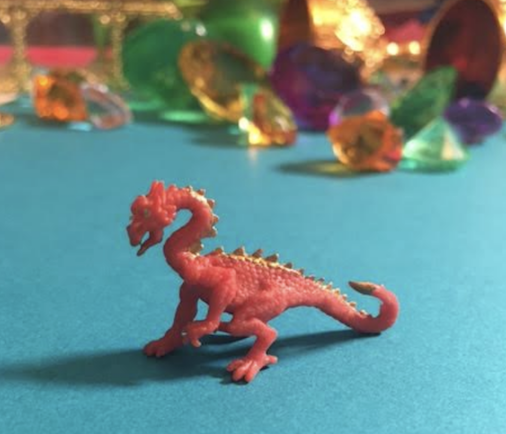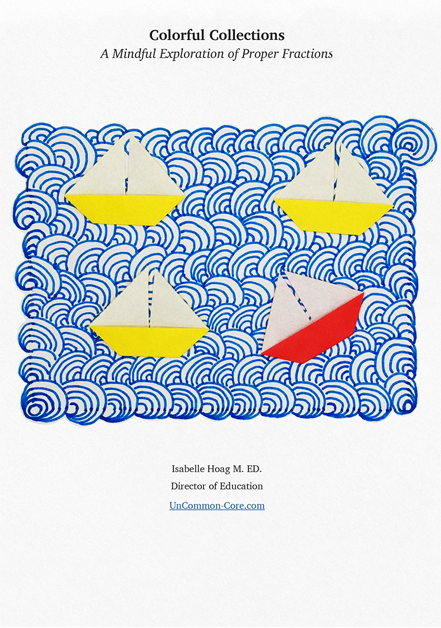
Do you want to grab your students attention in math class? Diamonds might work.
If real diamonds aren’t in your budget, try some colorful acrylic vase fillers (currently 240 pieces for $11) ~ such as the ones my fierce dragon from Safari LTD is guarding (pack of 8 assorted mythical minis $7.50) or this group of 36 two inch high draks (currently $13).
Not ready for a dragon? Then you might want to keep your gems safe in a couple of treasure chests ($8 for two) or sheer organza bags ($6 for 100 right now). Acrylic crystals ($7 for 600 this instant) can inspire young mathematicians just as well. These are great for using in small groups where you can keep an eye on the inventory.
Acrylic diamonds or crystals are perfect to use with a classroom bucket balance to teach number bonds such as 7+3=10. Sort them by color. Add 10 red crystals to one side and 7 blue crystals to the other. How many crystals are needed to balance the equation? Have a student add 3 yellow crystals to the bucket that has seven and watch the scales balance.
Be a savvy shopper.
The price, size, and quantity of deals on acrylic gems, wedding rings (200 for $8), mini erasers, spiders , cute countables (I’ve never used Temo), playsets ($11 for 60), and pirate coins ($7 for 144) are constantly in flux. Keep searching until you find a deal that is right for you.
Buying in bulk can give you the most value for your money however, you might end up with thousands of pieces! (I have never purchased from Alibaba.com, I’m just sharing what is out there.) Other teachers might want to share the costs ~ and the manipulatives ~ when you buy in bulk.
Naturally, shop out of season when possible. Since this is April, everything for Cinco De Mayo is spendy right now, whereas autumnal goodies are most likely on sale.
Even for items that are not seasonal or sold in bulk, you can usually find good deals such as multicolor pony beads (1000 for $5 at time of writing) which you could string on some chenille sticks also ($5 for 100 as I type) tie at both ends to make abacus style classroom counters. Check with the art teacher, they may have some of these items lying around.
Watch out! Shopping for slime charms can be slippery!
Some might seem like a great deal but turn out to be too small to use in class. Others like these intensely charming duckies or these ocean characters might seem expensive but turn out to be the perfect size! If there is no size listed, my guess is the items will be too small to use in a math class.
Like slime charms, polished pebbles and seashells can be a fantastic bargain and provide an interesting math manipulative for your students ~ if you’re careful. How many pebbles are in a two pound bag? This isn’t just a word problem ~ I really want to know. Be sure to compare the descriptions of the products with the titles and the photos to make sure you get what you need. For example, the description of the 2 pound bag of pebbles says they are all black, whereas the photos tell a different story.
Party supplies, fairy garden decorations, and cake toppers can also make engaging math manipulatives. However, like stones and shells, read the descriptions carefully. For example, these 12 unicorn cake toppers ($9) seem to be the same as these 8 unicorn cake toppers ($10).
Jump offline for unique deals.
For super affordable and fun items scour thrift stores and garage sales for things like chess or checker sets, puzzles, stickers, buttons, or other collections of small items. Some might need to be steam cleaned or spray painted but many can be used as they are. Office supply stores are another source math manipulatives. I’m thinking of paper clips, brads, erasers, and things like that.
Do you or any of your students drink bottled water? If so, save the twist-off tops, put colorful stickers on them and you’re ready to go. These make great counters and unit measures, but can’t be used with the bucket scale as they don’t weigh enough.
Finally, the grocery store is a good place for buying some cheap counters. There are all kinds of pastas in various shapes. You could get some mini marshmallows, then let them dry out before bringing them to school. Your students could become real bean counters! Any of these items could be spray painted or varnished to last longer.
While you are shopping at the store, check out containers with lids, mason jars, or baggies in which to store your new manipulatives. You might also look for some of the squishy, foam ear plugs. A couple boxes of birthday candles might be perfect to count or measure.
Everyday items that are interesting to look at, count, and measure are everywhere – keep your eyes open!
Please shop with your students in mind. Many of these small items are choking hazards. Before using food items in your class think about any of your students with diabetes, allergies, health issues, or those who might come from food insecure families.
I hope you find these ideas useful. I’m sharing some items that I have found to be good deals for use in my teaching, and some others that I think might be interesting. UnCommon-Core.com is not currently an affiliate marketer. Even if that changes in the future, it would not change the price you would pay.
All the best!
Share This Story, Choose Your Platform!
Download Colorful Collections:
A Mindful Exploration of Proper Fractions
Help your students make sense of fractions.
I started teaching in 1987, which means I’ve collected many tips and tricks along the way. In this ebook, I share concepts, strategies, and classroom materials to help you make math sticky.
Along with this useful ebook, you will receive weekly emails from StickyMath@UnCommon-Core.com. I send information like: teacher tips, educational ideas, book reviews, curated lists, reviews of educational sites, and free first drafts of products that I’m creating for my TPT store. That way, you get helpful ideas and free stuff, while I get some feedback before I finalize products and put them up for sale.
I value your privacy. I will never sell your information. You may unsubscribe at any time.
All the best!
Isabelle
Isabelle Hoag M. Ed.

